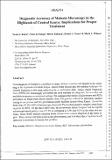Diagnostic Accuracy of Malaria Microscopy in the Highlands of Central Kenya: Implications for Proper Treatment

View/
Date
2013-06Author
Batra, Neale S.
Ndege, Peter K.
Kaburu, Mercy
Clauw, Daniel J.
Wilson, Mark L.
Type
ArticleLanguage
enMetadata
Show full item recordAbstract
Over-diagnosis of malaria is a problem in many African countries and appears to be occur¬ring in the highlands of central Kenya. Blood-smear microscopy, the standard technique for malaria diagnosis in this area, relies heavily on technician skill. Hence, Rapid Diagnostic Tests (RDTs) are increasingly considered the gold standard for diagnosis, but are often not available in resource-constrained settings. We compared the results of microscopy and RDTs performed on finger-prick blood samples from 250 patients referred to laboratory malaria testing at one private and two government health facilities in/near Meru, Kenya. Across the three sites, 97 .1%-100% of microscopy-diagnosed Plasmodium-positive samples were found negative by RDT. Of the three study sites, the government district hospital had the highest microscopy-based positive rate (27.3% as compared to 5.9% and 9.3% in the other two set¬tings). These results indicate alarming levels of inaccurate malaria diagnosis in the Meru re¬gion. Many factors may play a role in this phenomenon, and it is likely that a "systems level" approach is necessary to remedy this problem.
Publisher
IJPP
Description
p. 148 - 158
